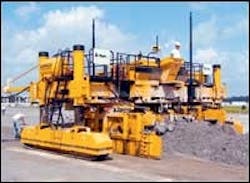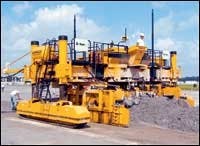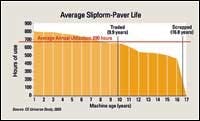High-Tech Grade Control Hits Slipform Pavers
- GOMACO
- HEM
- Guntert & Zimmerman
- Power Pavers
- Terex Roadbuilding
- Rexcon
Meeting the challenges of moving a concrete paver frequently between projects and configuring it quickly to different paving widths remains a key to most paver manufacturers' value propositions. But high-tech grade-control technologies are also pushing their way into the product-development process. The demand often comes from people who are using grade controls on other machines.
"Our field people became interested in stringless paving so we called GOMACO and Leica and sat down with them," says Paul Ondera, vice president of Head Inc. of Columbus, Ohio. "We went through the process and we became convinced that it would work. Our field people saw it as something they could use to become more efficient. It was their idea, and the attitude about instituting this change was really good company wide."
GOMACO rates its G21 electronics, and the gateway it represents to automatic three-dimensional grade control with Leica total-station lasers, as its most significant product development of the past few years. The paver manufacturer says Leica stringless technology is "plug-and-play" when used with its G21 digital control system.
Survey information that contractors gather to set stringline and determine the profile of a new roadway to be slipformed can also be used for three-dimensional stringless paving. The paver needs front and rear slope sensors to measure machine position and any cross slope in the slab. Robotic total stations track the paver on site with laser shots to prisms mounted on the machine. Leica's computer, loaded with latitudes, longitudes and elevations describing the desired grade for the pavement, is positioned next to the G21 controller on the paver and the two are interfaced.
When it's time to start slipforming, the paver is moved into position and the total stations are set up and oriented on the site map by taking measurements off the project site's predetermined reference points. The total stations are then aimed at the prisms on the paver, and they start tracking. The stations send paver coordinates to the Leica computer, which immediately determines if the paver is positioned correctly. The G21 controller, set to the Leica steering and elevation modes, automatically brings the paver on line and to level.
GOMACO customers are discovering that the system delivers accurately. Head Inc., for example, used the 3D grade controls on a trimmer/placer to place cement-treated base and the GHP-2800 paver to pave 3,760 feet of full-depth runway at the Baton Rouge Metropolitan Airport.
"Our requirements on this project and on most of the projects we work on, is .25-inch deviation on a 16-foot straight edge, and we easily accomplished that," says Ondera. "Tolerance-wise, with the stringless system, we're the same as we are on what we refer to as 'good stringline.' When you set stringline, if you set it well, if you set it right, and if you set it accurately, we can achieve plus or minus .125 inch, and we're able to get that with Leica."
The set-up process for three total stations to cover a long project and the Leica command center on the paver beats stringline setup.
"It's taking us an hour and a half to two hours to set the stringline we need for each pour," says Steve Melton, PCCP paving superintendent for another GOMACO customer, A.S. Horner. "It's taking us 35 minutes to set up the stringless system."
GOMACO uses the G21 controller and coordinating electric-over-hydraulic circuitry on its Commander III, GP-2600, and GHP-2800 slipform pavers. The GP-4000 also interfaces with stringless laser control systems.
Safety measures built into the automatic, 3D grade control system send an error signal to the computer and stop the measurement process if, for example, someone parks a truck in front of a total station and the laser can't hit the prism on the paver. The computer receives the error signal and sends a stop signal to the G21. The controller puts the paver into stand-by mode, shutting off the vibrators and augers until the problem is corrected.
Paving without a stringline not only saves set-up time, but also eliminates the cost of maintaining stringline and stakes. The jobsite is opened up so truckers are free to come and go without concerns about rolling over stringline, and workers no longer have to worry about getting tangled up in it. If one section of the job isn't completed on schedule, the paver can be moved to another part of the job to start paving without having to wait for stringline to be set.
Because there's a digital model of the entire project with the desired elevation at every point on the finished pavement programmed into the Leica computer, checking the paver's work becomes almost instantaneous.
"You can go anywhere behind the paver and set the rod with a prism, shoot at it with the total station, and the computer calculates what the elevation is supposed to be just as soon as it locates the prism," says Head's Ondera. "We can pave 10 feet and go back and check 10,000 different points on that piece of pavement. It's a tremendous advantage having the location and elevation of every point on the slab."
Guntert & Zimmerman remains focused on easy mobility and paving-width changes. It's an industry-wide preoccupation, with GOMACO's pivoting track arms, Terex ¦ CMI's hydraulic variable width machines, Power Pavers' hydraulic loading legs, and other manufacturers' approaches to loading a concrete paver on a trailer as quickly as possible.
Guntert & Zimmerman's most recent product introduction aims to put its Quadra telescoping frame system in the hands of more cost-sensitive buyers. The S850ST (for single telescoping) starts with the center tractor module and two Quadra Bolsters, which allow the tracks to telescope fore and aft. But rather than telescoping laterally to change paving width from both sides of the center module, the less-costly ST model telescopes from only one side of the tractor.
Paving widths range from 12 to 19 feet. Adding a pair of bolt-in Fixed Frame Extensions to the non-telescopic side of the center module creates a paving-width range of 18 to 25 feet. Additional extensions will take the maximum paving width out as far as 37½ feet.
The S850 with Quadra Bolsters self-loads on a trailer in one piece, including the paving kit, at a width of less than 12 feet. Load length is the paving width plus 12 feet. Guntert & Zimmerman's Compact Dowel Bar Inserter (CDBI) is also self-loading, without need for a crane, on a single truckload at less than 12 feet wide. The CDBI module mounts to a standard S850 paver without need for a crane.
Terex Roadbuilding continues to refine the paving results of what they call the industry's first field-proven slipform paver to adjust widths hydraulically, the SF2204B Hydraulic Variable Width, a machine initially designed and built by CMI. A modular paving kit mounted to the paver's sub-frame uses the mainframe's telescoping action to position dual tandem paving molds laterally to change widths.
"The SF2204B HVW goes from its minimum paving width of 8 feet to its maximum 20-foot paving width in minutes, rather than hours," according to the Terex Roadbuilding release.
Concrete-pan profile length on the B Series HVW machine doubled to 48 inches to help "maintain quality paving results when using commercial ready-mix concrete."


